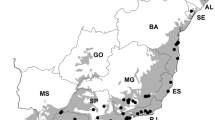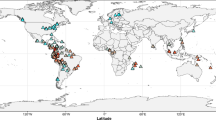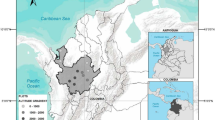Abstract
Niche processes and other spatial processes, such as dispersal, may simultaneously control beta diversity, yet their relative importance may shift across spatial and temporal scales. Although disentangling the relative importance of these processes has been a continuing methodological challenge, recent developments in multi-scale spatial and temporal modeling can now help ecologists estimate their scale-specific contributions. Here we present a statistical approach to (1) detect the presence of a space–time interaction on community composition and (2) estimate the scale-specific importance of environmental and spatial factors on beta diversity. To illustrate the applicability of this approach, we use a case study from a temperate forest understory where tree seedling abundances were monitored during a 9-year period at 40 permanent plots. We found no significant space–time interaction on tree seedling composition, which means that the spatial abundance patterns did not vary over the study period. However, for a given year the relative importance of niche processes and other spatial processes was found to be scale-specific. Tree seedling abundances were primarily controlled by a broad-scale environmental gradient, but within the confines of this gradient the finer scale patchiness was largely due to other spatial processes. This case study illustrates that these two sets of processes are not mutually exclusive and can affect abundance patterns in a scale-dependent manner. More importantly, the use of our methodology for future empirical studies should help in the merging of niche and neutral perspectives on beta diversity, an obvious next step for community ecology.




Similar content being viewed by others
References
Abrams MD (1998) The red maple paradox: what explains the widespread expansion of red maple in eastern forests? BioScience 48:355–364
Anderson MJ, Legendre P (1999) An empirical comparison of permutation methods for tests of partial regression coefficients in a linear model. J Stat Comput Simul 62:271–303
Ashton PMS, Yoon H, Rajesh T, Berlyn GP (1999) Seedling leaf structure of New England maples (Acer) in relation to light environment. For Sci 45:512–519
Barot S, Gignoux J (2004) Mechanisms promoting plant coexistence: can all the proposed processes be reconciled? Oikos 106:185–192
Bélanger N, Côté B, Fyles JW, Courchesne F, Hendershot WH (2004) Forest regrowth as the controlling factor of soil nutrient availability 75 years after fire in a deciduous forest of Southern Quebec. Plant Soil 262:363–372
Bell G, Lechowicz MJ, Appenzeller A, Chandler M, Deblois B, Jackson L, Mackenzie B, Preziosi R, Schallenberg M, Tinker N (1993) The spatial structure of the physical environment. Oecologia 96:114–121
Bell G, Lechowicz MJ, Waterway MJ (2006) The comparative evidence relating to functional and neutral interpretations of biological communities. Ecology 87:1378–1386
Borcard D, Legendre P (1994) Environmental control and spatial structure in ecological communities: an example using Oribatid mites (Acari, Oribatei). Environ Ecol Stat 1:37–61
Borcard D, Legendre P (2002) All-scale spatial analysis of ecological data by means of principal coordinates of neighbour matrices. Ecol Modell 153:51–68
Borcard D, Legendre P, Avois-Jacquet C, Tuomisto H (2004) Dissecting the spatial structure of ecological data at multiple scales. Ecology 85:1826–1832
Borcard D, Legendre P, Drapeau P (1992) Partialling out the spatial component of ecological variation. Ecology 73:1045–1055
Burns RM, Honkala BH (1990) Silvics of North America, vol 2: hardwoods. USDA Agricultural Handbook No. 654. U.S. Department of Agriculture, Washington DC
Chave J, Leigh EG (2002) A spatially explicit neutral model of beta-diversity in tropical forests. Theor Popul Biol 62:153–168
Clark JS, LaDeau S, Ibanez I (2004) Fecundity of trees and the colonization-competition hypothesis. Ecol Monogr 74:415–442
Cottenie K (2005) Integrating environmental and spatial processes in ecological community dynamics. Ecol Lett 8:1175–1182
Courchesne F, Côté B, Fyles JW, Hendershot WH, Biron PM, Roy AG, Turmelet M-C (2005) Recent changes in soil chemistry in a forested ecosystem of southern Québec, Canada. Soil Sci Soc Am J 69:1298–1313
Courchesne F, Hendershot WH (1988) Cycle annuel des éléments nutritifs dans un bassin-versant forestier: contribution de la litière fraîche. Can J For Res 18:930–936
Currie DJ (2007) Disentangling the roles of environment and space in ecology. J Biogeogr 34:2009–2011
Draper NR, Smith H (1981) Applied regression analysis. Wiley, New York
Dray S (2005) packfor: forward selection with multivariate Y by permutation under reducel model. Laboratoire Biométrie et Biologie Évolutive, Lyon. Available at: http://biomserv.univ-lyon1.fr/~dray/software.php
Dray S, Legendre P, Peres-Neto P (2006) Spatial modeling: a comprehensive framework for principal coordinate analysis of neighbor matrices (PCNM). Ecol Modell 196:483–493
Englund SR, O’Brien JJ, Clark DB (2000) Evaluation of digital and film hemispherical photography and spherical densiometry for measuring forest light environments. Can J For Res 30:1999–2005
Frazer GW, Canham CD, Lerstzan KP (2000) Gap light analyzer version 2.0. Bull Ecol Soc Am 81:191–197
Freestone AL, Inouye BD (2006) Dispersal limitation and environmental heterogeneity shape scale-dependent diversity patterns in plant communities. Ecology 87:2425–2432
Gilbert B, Lechowicz MJ (2004) Neutrality, niches, and dispersal in a temperate forest understory. Proc Natl Acad Sci USA 101:7651–7656
Griffith DA, Peres-Neto PR (2006) Spatial modeling in ecology: the flexibility of eigenfunction spatial analyses. Ecology 87:2603–2613
Hibbs DE, Fischer BC (1979) Sexual and vegetative reproduction of striped maple (Acer pensylvanicum L.). Bull Torrey Bot Club 106:222–227
Hibbs DE, Wilson BF, Fischer BC (1980) Habitat requirements and growth of striped maple (Acer pensylvanicum L.). Ecology 61:490–496
Holyoak M, Loreau M (2006) Reconciling empirical ecology with neutral community models. Ecology 87:1370–1377
Host GE, Pregitzer KS, Ramm DW, Hart JB, Cleland DT (1987) Landform-mediated differences in successional pathways among upland forest ecosystems in northwestern lower Michigan. For Sci 33:445–457
Houle G (1991) Regenerative traits of tree species in a deciduous forest of northeastern North America. Holarctic Ecol 14:142–151
Houle G (1992) Spatial relationship between seed and seedling abundance and mortality in a deciduous forest of north-eastern North America. J Ecol 80:99–108
Houle G (1994) Spatiotemporal patterns in the components of regeneration of four sympatric tree species—Acer rubrum, A. saccharum, Betula alleghaniensis and Fagus grandifolia. J Ecol 82:39–53
Houle G (1999) Mast seeding in Abies balsamea, Acer saccharum and Betula alleghaniensis in an old growth, cold temperate forest of north-eastern North America. J Ecol 87:413–422
Hubbell SP (2001) The unified neutral theory of biodiversity and biogeography. Princeton University Press, Princeton
Hubbell SP, Foster RB, O'Brian ST, Harms KE, Condit R et al (1999) Light-gap disturbances, recruitment limitation, and tree diversity in a neotropical forest. Science 283:554–557
John R, Dalling JW, Harms KE, Yavitt JB, Stallard RF et al (2007) Soil nutrients influence spatial distributions of tropical tree species. Proc Natl Acad Sci USA 104:864–869
Jones MM, Tuomisto H, Borcard D, Legendre P, Clark DB, Olivas PC (2008) Explaining variation in tropical plant community composition: influence of environmental and spatial data quality. Oecologia 155:593–604
Jones MM, Tuomisto H, Clark DB, Olivas P (2006) Effects of mesoscale environmental heterogeneity and dispersal limitation on floristic variation in rain forest ferns. J Ecol 94:181–195
Karst J, Gilbert B, Lechowicz MJ (2005) Fern community assembly: the roles of chance and the environment at local and intermediate scales. Ecology 86:2473–2486
Legendre L, Gallagher ED (2001) Ecologically meaningful transformations for ordination of species data. Oecologia 129:271–280
Legendre P (1993) Spatial autocorrelation: trouble or new paradigm? Ecology 74:1659–1673
Legendre P, Anderson MJ (1999) Distance-based redundancy analysis: testing multispecies responses in multifactorial ecological experiments. Ecol Monogr 69:1–24
Legendre P, Borcard D, Peres-Neto P (2005) Analyzing beta diversity: partitioning the spatial variation of community composition data. Ecol Monogr 75:435–450
Legendre P, Legendre L (1998) Numerical ecology, 2nd English edn. Elsevier, Amsterdam
Levin SA (1992) The problem of pattern and scale in ecology. Ecology 73:1943–1967
Nathan R, Katul GG (2005) Foliage shedding in deciduous forests lifts up long-distance seed dispersal by wind. Proc Natl Acad Sci USA 102:8251–8256
Nowacki GJ, Arbams MD, Lorimer CG (1990) Composition, structure, and historical development of northern red oak stands along an edaphic gradient in north-central Wisconsin. For Sci 36:276–292
Oksanen J, Kindt R, Legendre P, O’Hara B (2007) vegan: community ecology package, version 1.8-5. Available at: http://cran.r-project.org/
Paquette A, Laliberté E, Bouchard A, de Blois S, Legendre P, Brisson J (2007) Lac Croche understory vegetation data set (1998–2006). Ecology 88:3209
Peres-Neto P, Legendre P, Dray S, Borcard D (2006) Variation partitioning of species data matrices: estimation and comparison of fractions. Ecology 87:2614–2625
R Development Core Team (2007) R: a language and environment for statistical computing, version 2.3.1. R Foundation for Statistical Computing, Vienna. Available at: http://www.r-project.org/
Ricklefs RE, Schluter D (1993) Species diversity in ecological communities: historical and geographical perspectives. University of Chicago Press, Chicago
Savage C (2001) Recolonisation forestière dans les Basses Laurentides au sud du domaine climacique de l’érablière à bouleau jaune. MSc thesis. Département de sciences biologiques, Université de Montréal, Montreal
Schwarz PA, Fahey TJ, McCulloch CE (2003) Factors controlling spatial variation of tree species abundance in a forested landscape. Ecology 84:1862–1878
Seidler TG, Plotkin JB (2006) Seed dispersal and spatial pattern in tropical trees. PLoS Biol 4:1–6
Soil Survey Division Staff (1993) Soil survey manual. Soil Conservation Service, United States Department of Agriculture (USDA), Washington DC
Soininen J, Lennon JJ, Hillebrand H (2007) A multivariate analysis of beta diversity across organisms and environments. Ecology 88:2830–2838
Tuomisto H, Ruokolainen K, Yli-Halla M (2003) Dispersal, environment, and floristic variation of Western Amazonian forests. Science 299:241–244
Van der Gucht K, Cottenie K, Muylaert K, Vloemans N, Cousin S et al (2007) The power of species sorting: local factors drive bacterial community composition over a wide range of spatial scales. Proc Natl Acad Sci USA 104:20404–20409
Venables WN, Ripley BD (2002) Modern applied statistics with S, 4th edn. Springer, New York
Wiens JA, Addicott JF, Case TJ, Diamond J (1986) Overview: the importance of spatial and temporal scale in ecological investigations. In: Diamond J, Case TJ (eds) Community ecology. Harper & Row, New York, pp 145–153
Acknowledgments
We wish to thank F. He, J. Oksanen, K.L. Gross, J.B. Grace and anonymous reviewers for helpful comments on previous versions of the manuscript. This work was made possible by a large number of people involved in data collection from 1998 through 2006. For supervision of field work, we wish to thank K. Benjamin, J. Corriveau, G. Couture, C. Savage, R. Léonard, L. d’Orangeville, M. Lapointe, J. Thibeault, P.-O. Roy, M.-A. Vaillancourt, R. Schmucki, J. Villeneuve and G. Maltais-Landry. Thanks to the staff of Station de biologie des Laurentides (SBL) for support. This research was funded by a NSERC grant to A. Bouchard and by the Département de sciences biologiques of Université de Montréal. During the writing of this manuscript, E. Laliberté was supported by scholarships from the University of Canterbury and the Fonds québécois de recherche sur la nature et les technologies (FQRNT).
Author information
Authors and Affiliations
Corresponding author
Additional information
Communicated by Katherine Gross.
Electronic supplementary material
Below is the link to the electronic supplementary material.
Rights and permissions
About this article
Cite this article
Laliberté, E., Paquette, A., Legendre, P. et al. Assessing the scale-specific importance of niches and other spatial processes on beta diversity: a case study from a temperate forest. Oecologia 159, 377–388 (2009). https://doi.org/10.1007/s00442-008-1214-8
Received:
Accepted:
Published:
Issue Date:
DOI: https://doi.org/10.1007/s00442-008-1214-8




